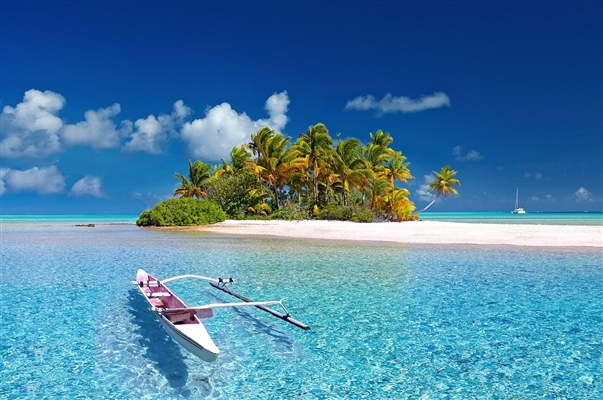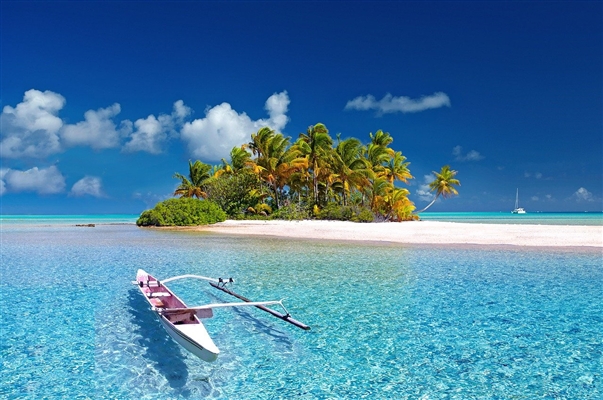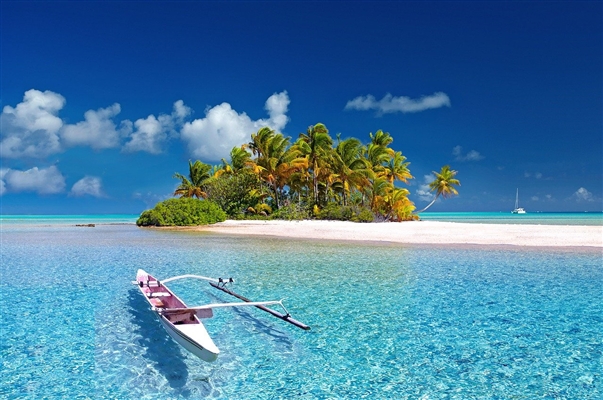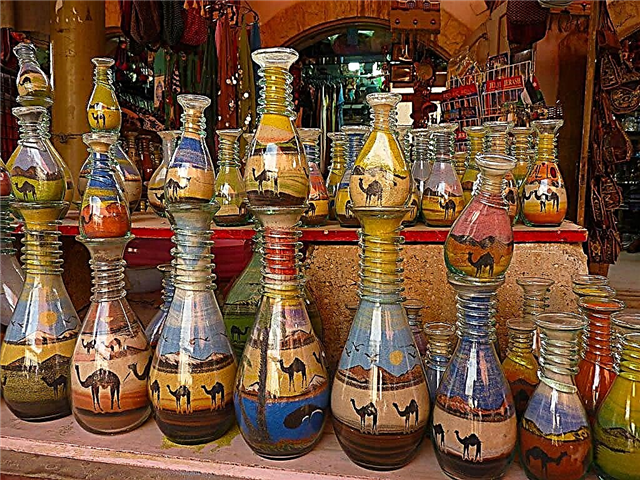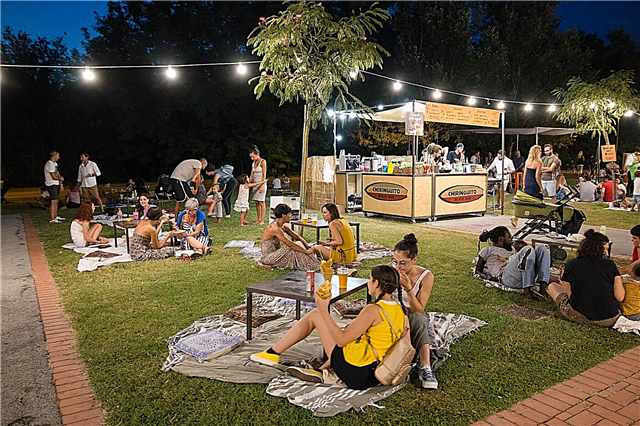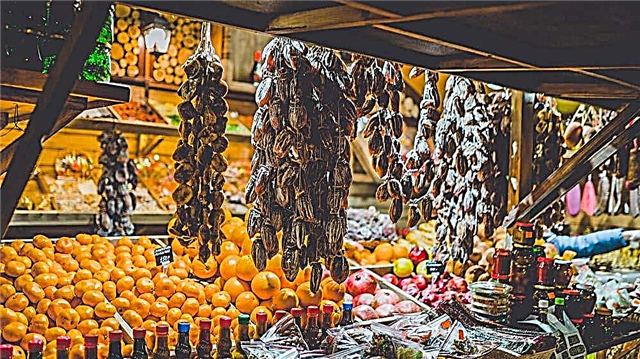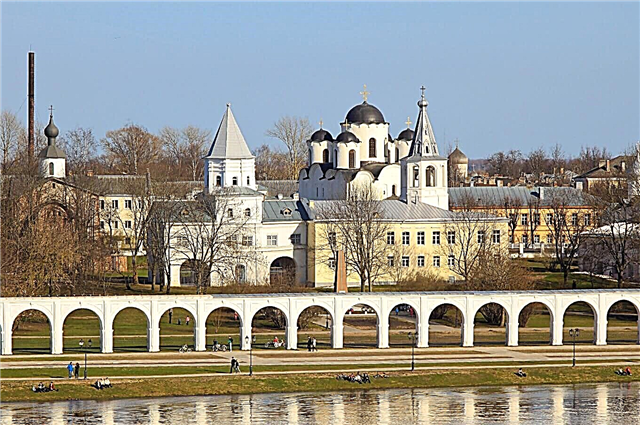The ancient city, the history of which has more than 13 centuries, has preserved the atmosphere and spirit of Ancient Russia. The historical center of Veliky Novgorod with architectural monuments of the XI-XVI centuries is included in the list of objects protected by UNESCO. The main attraction, where people try to get in first of all, is the Novgorodsky Detinets. Historical and cultural monuments of different eras and styles have been preserved on its territory.
Particular attention should be paid to religious buildings - churches, cathedrals, temples, monasteries. Most of them have preserved not only the walls, but also the interior painting during their centuries-old history. For example, in the Church of the Transfiguration of the Savior, unique frescoes of 1378 by Theophanes the Greek have been preserved. The real open-air museums are Vitoslavitsy, Yaroslav's Court and Torg, monastic complexes.
The most interesting and beautiful places
List, photo with names and descriptions of popular sights of Veliky Novgorod, which will help you draw up routes for exploring the city in 1-3 days.
Novgorod Detinets
It was first mentioned in chronicles in 1044. The ancient mighty fortress is an architectural monument under the protection of UNESCO. The area of the modern Kremlin is 12 hectares, the length of the walls is 1.5 km, the height of the towers is 41 meters. Climbing the fortress walls and visiting 9 towers is possible only in good weather. Interesting objects for viewing are the ancient cathedral and churches, the Clockwork, the Faceted Chamber, the sculpture “Millennium of Russia”.
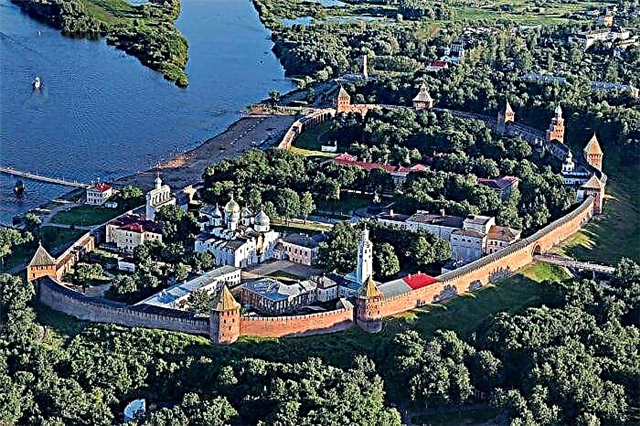
Read about all the best places in the region: the main attractions of the Novgorod region.
Yaroslav's Court and Bargaining
An extensive historical and architectural complex, founded in the X-XI century. This place has preserved the spirit and atmosphere of the ancient city. Bargaining was the economic center of Veliky Novgorod - along it stretched long trade rows. The old commercial buildings now house cafes and small shops. Especially interesting is the Yaroslav's Court with a large number of ancient churches of the XII-XVIII centuries.

"Vitoslavlitsy"
Museum of Ancient Wooden Folk Architecture, located a few kilometers from the city near Lake Myachino. The name of the museum is given by the name of the village at this place in the XII-XVIII centuries. The open-air museum includes ancient buildings of the XIII-XIX centuries - peasant huts, a chapel, churches, temples, a mill. They were brought here from all over the Novgorod region. Folk festivities and folklore festivals are held on the territory of the museum.

Sophia Cathedral
It was founded in the 11th century and is one of the symbols of Veliky Novgorod. The majestic religious stone building has five domes, similar to heroic helmets. Four of the domes are steel, the fifth is gold. The decoration of the temple is the bronze Magdeburg Gate with high reliefs and beautiful sculptures. Another treasured relic is the Vasilievsky Gate with images of biblical subjects and the ancient hero Kitovras.

Kremlin park
Occupies an area of 25 hectares. On three sides, the park frames the walls of the Detinets. The park has many opportunities for active leisure - a go-kart track, boat rental, a field for playing towns and a tennis court. From the pedestrian walkway you can enjoy beautiful views of the ancient fortress or appreciate the beauty of the streams of the Sadko fountain. The park has several monuments and memorials, a stage for concerts and attractions.

Monument "Millennium of Russia"
Installed on the Kremlin Square in 1862 as part of the celebration of the 1000th anniversary of the Russian statehood. The composition is based on the “cap of Monomakh”, which consists of an orb in the form of a ball, mounted on a bell-shaped pedestal. The monument is 15.7 meters high and weighs over 100 tons. On its tiers there are 128 figures - grand dukes, statesmen, artists and writers, war heroes.

About the best monuments article: 30 main monuments of Veliky Novgorod.
Pedestrian bridge over the Volkhov river
Located in the area of Yaroslav's Court. The first city bridge was first mentioned at the beginning of the 12th century. It was rebuilt several times and functioned until 1944, when it was blown up by German troops. The bridge was restored only in 1987 according to a unique project of the engineers of the Leningrad Institute. The pedestrian bridge has an interesting curved shape with an arched outline. It connects two historic urban areas.

Rurik's settlement
Archeological monument of the 9th century near Lake Ilmen. According to ancient chronicles, several centuries ago, the prince's residence was located here. According to legend, it was this place that was the capital of the state of Rurik after he was called to the kingdom by the Vikings. During excavations at this place, a large number of items from the Scandinavian times were found, as well as settlements from the Iron Age. The ruins of the Church of the Annunciation have been preserved on the site.

Lake Ilmen
A large lake, into which about 50 rivers flow, and only one flows out - the Volkhov, which connects Ilmen with Lake Ladoga. Previously, trade routes passed through the lake, now it is used as a place for outdoor recreation. On its shore there is a natural monument - Ilmensky glint. The forests surrounding the lake are full of berries and mushrooms. Recreation centers have been built, where guests are offered various types of active leisure.

Sights of the Kremlin and its environs
The most interesting places on the Sofia side of the city. Most of them are concentrated on the territory of the Kremlin and next to its walls.
Victory-Sofiyskaya Square
The original name of the square - Sofiyskaya was received in the 19th century, and it was renamed into Victory Square in 1946. In the 1990s, the square was given a double name - in tribute to the events of the war and its history. It adjoins the walls of the Kremlin and the Kremlin Park. In summer, the main decoration of the square is a large and bright blooming flower bed in the center, and in winter, the main city Christmas tree is erected here.

Victory Monument
Installed in 1974 in honor of the 30th anniversary of the liberation of the city from the Nazi invaders. As conceived by the authors of the monument, the monument symbolizes the might of the USSR and the feat of the people. In the center of the composition is a rearing horse with a rider sitting on it. Under the horse's hooves is a defeated swastika. Behind the sculpture is a 23.5-meter tower, on top of which is a boat with ancient military attributes.

Sofiyskaya embankment
It is laid along the Volkhov River from the historical part of the city. The old iconic buildings of the city are clearly visible from the embankment. Several years ago, it underwent a large-scale reconstruction, in which the historical component was combined with modern design solutions. The beach area has a volleyball court, kiosks with drinks and ice cream, a boat rental, a playground.

"Hourly Calling"
The clock tower in Novgorod Detinets. Built in 1673. This is the tallest structure in Detinets, and it is one of the most recognizable in the city. The tower is slightly inclined towards the northwest. The four dials of the tower are linked by one movement. Previously, every half hour they fought back with the strikes of a 60-pound bell made in 1647. Through the passage arch in the tower you can get to the Metropolitan and Fedorovskaya tower.
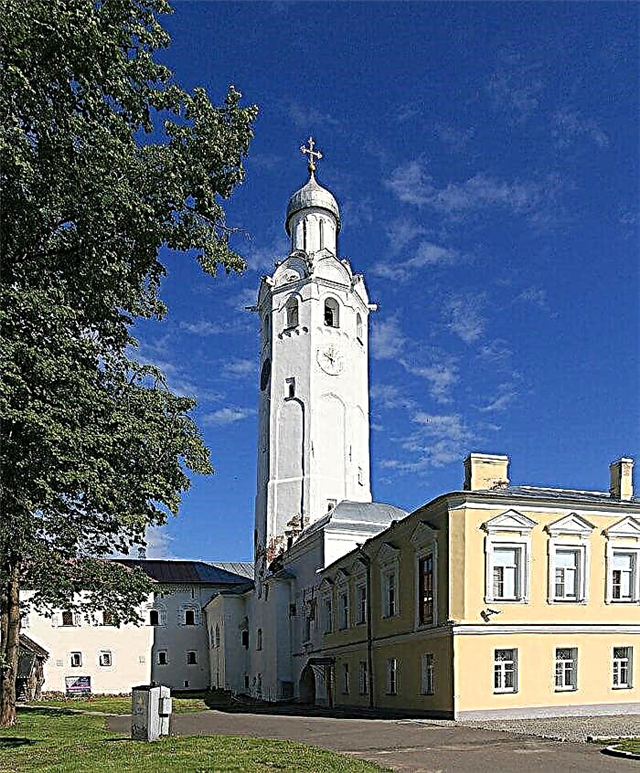
Sovereign (Faceted) Chamber
An architectural monument of the 15th century, built in the brick Gothic style. Included in the UNESCO list. German craftsmen took part in the creation of the chamber, who decorated the ceremonial hall with lancet windows and star vaults. This hall was intended for ceremonies, receiving important guests and state meetings. Currently, the building is being reconstructed and given a historical look.

Public places building
Built on the territory of the Novgorod Kremlin in the 18th century. The architecture of the building has changed several times due to partial destruction. Currently, it is a building of a strict rectangular shape in the style of late classicism. Some of the facades protrude slightly forward beyond the main line. The windows are decorated with large castle stones. The building houses the regional library and several museum departments.

Fountain "Sadko and Princess Volkhova"
It is considered the main city fountain. Built in 1978 according to the project of Kurylev, a Novgorod architect. In the center of the fountain are the figures of the heroes of Russian epic legends. They stand on a large bowl decorated with mosaic patterns. Previously, there was a bust of Stalin instead of figures in the fountain. During the reconstruction in 2009, beautiful lighting was added to the fountain and the water circulation systems were updated.

Kremlin beach
It is located at the walls of the Novgorod Kremlin on the banks of the Volkhov River - hence its name. A cozy and clean beach is loved by the residents of the city. In warm weather, many people gather here to swim in the river or sunbathe. The sandy beach is well equipped - there are changing cabins, dry closets, sun umbrellas. Families with children will appreciate the presence of children's playgrounds and sports grounds, a gentle entrance to the water.

Alekseevskaya tower
Also known as the White Tower. The only surviving stone tower from the defensive structure of the Round City. It was built in the 16th century. The diameter of the Alekseevskaya Tower is 17 meters. The first tier of walls is built of cobblestones and faced with bricks. The thickness of the walls in this place is 4.5 meters. Stairs are laid through three tiers of the tower walls. An exhibition of ancient Russian weapons is located inside the tower.

Dostoevsky Academic Drama Theater
The first stationary theater of Veliky Novgorod. It was opened in 1825 in the building of a former merchant mansion. And the drama theater itself has been known since the 16th century. The creativity of Novgorodian buffoons-lycees was popular throughout Russia. Since 1987, the theater has been housed in a building specially built by the architect Somov. It has an original look, distinguished by the shape of the windows, in the design of which the musician A. Makarevich took part.

Art Museum
Located in the halls of the building of the Noble Assembly. This beautiful building hosts winter balls and wedding ceremonies. The exposition of the museum is dedicated to Russian art of the 17th-20th centuries - painting, sculpture, graphics, portrait miniatures. There are paintings by Bryullov, Repin, Aivazovsky, sculptures by Vrubel, Trubetskoy and Antokolsky. In total, there are about 650 works of art in 9 halls of the museum.

Church of Peter and Paul in Kozhevniki
The old church was built in 1406 and is a cultural heritage site. It is a four-pillar one-domed temple. The walls of the church are made of bricks and limestone blocks, they are not plastered. The only decoration is brick ornament on the facades. Currently, the premises of the church houses a museum. Church icons can be viewed in the Novgorod Historical Museum.

Monument to Sergei Rachmaninoff
Located on the territory of the Kremlin Park. Opened in 2009. The money for the creation of the monument was collected by residents and enterprises of the city. The monument to the famous composer was designed by the sculptor Rukavishnikov. The figure of Rachmaninov, 3.6 meters high, is made of bronze. The weight of the monument is 3 tons. Rachmaninov's music plays quietly from the speakers located on the lampposts near the monument.

Attractions on the Trade Side
This is the right bank of the Volkhov River. As a rule, people come here after seeing the main attractions in Novgorodsky Detinets.
Arcade Gostiny Dvor
Historic building, erected in the 18th century. The only surviving fragment of the Gostiny Dvor after the destruction during the Great Patriotic War. The arcade is made in the style of strict classicism. In 1956, during the demolition of the remains of the Gostiny Dvor structures, the arcade was reconstructed and extended by several links to maintain symmetry. The surviving arcade is one of the symbols of Yaroslav's Dvorishch and Bargaining.

Alexander Nevsky embankment
Located on the right bank of the Volkhov River. Passes from the arcade of the Gostiny Dvor to the Church of Boris and Gleb. The length of the embankment is 1.5 km. The general appearance of the Nevsky embankment was created in the 18th century. Since then, it has been repeatedly landscaped and reconstructed - shrubs and trees have been planted, monuments and art objects have been erected. The historic buildings located nearby give a special picturesqueness to the embankment.

Gate tower of Gostiny Dvor
Built in the 17th century. The three-storey building has two passable arches. An octagonal tower topped with a tent rises above the middle of the building. Along the tanks from it, in the lower part, there are passage arches to the Gostiny Dvor. In the premises of the tower there is an exhibition of Christian antiquities of the XI-XIX centuries, where about 300 works of non-ferrous metals are exhibited. The observation tower offers an excellent view of the city.

Hanseatic fountain
It is located on the territory of Yaroslav's Court. It has an unusual appearance - there are no gushing jets of water in it. Instead of the usual bowl - a granite pool in black. In the middle of the bowl is a small spring, from which water flows over the pool and surrounding stones. The coats of arms of the countries of the modern Hanseatic League are depicted along the perimeter of the basin. The very shape of the pool circle symbolizes the negotiation table.

Nikolo-Dvorishchensky Cathedral
One of the oldest cathedrals in the city. It was founded in 1113. It is located in the Yaroslav's Dvorishche and is considered the main architectural structure among the Torg ensemble. The cathedral was built according to the traditions of Kiev religious architecture. This is a grandiose six-pillar structure with five chapters with a restrained and austere facade design. Several fragments have survived from the frescoes on the walls.

Church of Paraskeva-Friday at Torgu
It was first mentioned in ancient chronicles in 1207. The church was rebuilt several times, but its modern appearance allows you to imagine its original appearance. During the restoration, the old masonry of the 13th-16th centuries was freed from the layers of plaster. The dome of the 18th century has been preserved unchanged. The church houses a museum exposition telling about the ancient Novgorod architecture.

Temple of the Myrrh-Bearing Women
Built in the 1510th century on the site where churches were built over the course of several centuries. It was the "family" church of the family of the merchant Syrkov, who financed the construction. The temple is one-domed. The belfry is located on its western side. One of the three floors of the temple is located below ground level. Two staircases with wooden porches lead to the main upper floor. The premises of the church are occupied by a cultural center for children.

Monument to a tourist girl
One of the most unusual modern monuments in Veliky Novgorod. It was installed at the pedestrian bridge over the Volkhov River. The monument depicts a tourist girl, tired of a long walk and sitting down to rest on the parapet. The girl's shoes are off and her head is thrown back, which gives the sculpture a romantic look. At the unveiling of the monument in 2009, Dmitry Medvedev was present, who even took a photo next to the monument.

Church of Boris and Gleb on Plotniki
It is a cultural heritage site and is under the protection of UNESCO. Built in 1536 in a record short time - 5 months. Presumably, the church was built on the foundations of a wooden church that had previously stood here, which partially determined the construction plan. The five-domed brick church was built according to the traditions of Novgorod architecture. Part of the old iconostasis is currently kept in the Novgorod Museum.
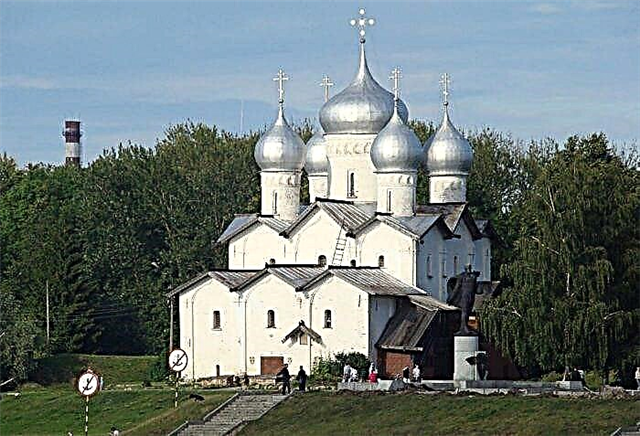
Monument to Alexander Nevsky
Installed in 1985 near the embankment and the bridge bearing the name of the great commander.The project of the monument was created by the architect Isakovich, completed by the sculptor Yuri Chernov. Nevsky walks forward, raising his head to the sky, and a cloak develops behind his shoulders. His sword is sheathed. With a certain angle and lighting, it seems that the Grand Duke has wings behind his back. His face expresses openness and confidence.

Center for Musical Antiquities V.I. Povetkin
An unusual and unique museum. The founder of the museum, Vladimir Povetkin, based on archaeological fragments, created a collection of musical instruments from the 10th-15th centuries, and also voiced it. Vladimir Ivanovich himself developed an interesting technique for reconstructing horns, snouts, gusli, jew's harps. Povetkin's work on restoring the sound of ancient instruments is continued by experts in musical archeology.

Church of Theodore Stratilates on the Brook
The Orthodox church was built in the 1360s. Currently, within its walls is a branch of the Novgorod Museum. The building of the church is made in the traditional style of Novgorod architecture and is an architectural monument of the Middle Ages. Fragments of frescoes from the 14th century, which are made in brown and red, have been preserved in the church. On the outside of the church, scholars read several medieval humorous graffiti.

Cathedral of the Sign
Founded in 1682 on the site of a 14th century church. The temple burned several times; during the Great Patriotic War, German barracks were located in it at one time. In the 20th century, large-scale work was carried out to reconstruct the cathedral, including the restoration of wall frescoes by Moscow artists. Within the boundaries of the cathedral, the traditions of Central Russian architecture are clearly visible, which have survived despite numerous rebuildings.

Church of the Transfiguration of the Savior on Ilyin Street
Built in 1374. The uniqueness of the church is that frescoes by the master of icon painting Theophanes the Greek, made in 1378, have been preserved in it. Outwardly, the church looks monumental and exquisite, while the architectural features traditional for that time are clearly traced in it. The facades of the temple are richly decorated with arches, narrow lancet windows, brick ornaments, relief and carved crosses.

Monasteries of Veliky Novgorod
The main places of worship in the city are ancient monasteries with historical temples and churches. This is the most important part of the cultural heritage of Veliky Novgorod.
Yuriev monastery
Monastery, located on the outskirts of the city on the banks of the Volkhov River. Founded in 1030 and is a UNESCO protected site. The initiator of the creation of the monastery was the Grand Duke Yaroslav the Wise. The monastery includes three cathedrals - St. George, Holy Cross and Spassky, churches of Michael the Archangel and the icon of the Mother of God "Burning Bush", a four-tiered bell tower 52 meters high.
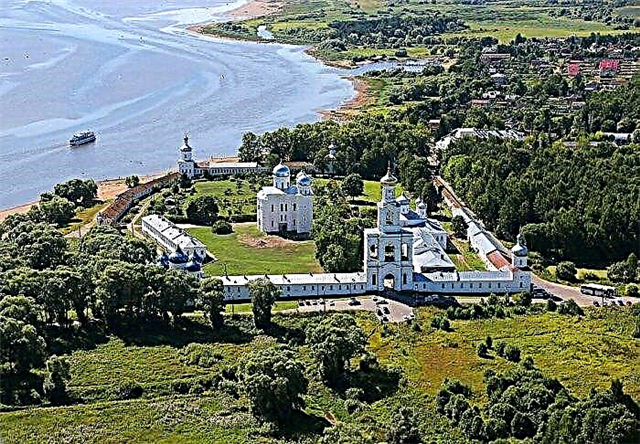
Khutynsky monastery
Located 7 km from the city on the outskirts of the village of Khutyn. Founded in 1190 by the monk Varlaam, according to legend, he expelled evil spirits from these places. The most famous building of the monastery was the Church of St. Gregory of Armenia, now only ruins remain of it. The grave of the poet Derzhavin is located within the walls of the Transfiguration Cathedral. Currently, the monastery is being actively restored after the destruction during the Soviet era.

Nikolo-Vyazhischsky monastery
It was founded in 1411 and has a high stavropegic status - directly subordinate to the patriarch. The monastery had a high status even in the 17th century - it was patronized by tsars from the Romanov dynasty. To date, several ancient centuries-old buildings have survived - St. Nicholas Cathedral, the Church of the Evangelist John the Theologian and the Church of St. Apostle, decorated with colored tiles on the outer sides of the buildings.

Klopsky Holy Trinity Monastery
Monastery, located 20 km from Veliky Novgorod at the confluence of the Veryazhi and Ilmen. Founded in 1408. The central building of the monastery is the Trinity Cathedral, built in the 1560s and preserved to this day. From 1934 to 2005, the monastery did not function; during the Great Patriotic War, its buildings were badly damaged. Restoration work is currently underway at the monastery.

Perynsky skete
The date of foundation is 995. Presumably the skete was founded on the site of a pagan temple. In the documents, the skete was first mentioned in 1386, as one of the monasteries burned down by the Novgorodians before the arrival of the troops of Dmitry Donskoy. Now the skete belongs to the St. George Monastery. On its territory there is one of the architectural monuments of the XIII century - the Church of the Nativity of the Virgin, measuring only 7.5 * 9 * 12 meters.

Antoniev monastery
The monastery was founded in 1106 and abolished in 1920. The Cathedral of the Nativity of the Virgin, built at the beginning of the 12th century, shortly after the founding of the monastery, has survived from the monastery buildings to this day. Since 1125, frescoes have been preserved on the walls of the cathedral, which in the XX century were found under the paintings of the XIX century, they were cleaned and restored. The premises of the monastery now house the faculties of the Yaroslav the Wise University.

Zverin-Pokrovsky Monastery
It is located near the confluence of the Gzen River and the Volkhov River. The exact date of construction has not been established; in the documents it is first mentioned in 1148, as burned down by a lightning strike. The monastery flourished in the 19th century. The main monastery church of the Intercession of the Virgin has been known since the 12th century. The church of Simon the God-Receiver with 15th century frescoes has been preserved since 1467. The Intercession Cathedral has been in operation since 1899.

Derevyanitsky monastery
It was first mentioned in chronicles in 1335. The main Resurrection Cathedral was built in 1700. It has an unusual design - all the complex vaults of the cathedral are held on only two pillars. Its facades are decorated with figured stone. In 1725, the Church of the Assumption of the Virgin with a five-tiered bell tower was erected. The figured end of the bell tower gives expressiveness to the entire monastery ensemble.

Tithes monastery
The now abolished monastery, which was first mentioned in the Novgorod chronicles in 1327. The ruins of the Church of the Nativity of the Virgin, built in 1327, several buildings and a bell tower, built in 1809 and rebuilt in 1903, have survived from the entire monastery ensemble to this day. One of the surviving and restored nursing buildings now houses the Museum of Artistic Culture of Veliky Novgorod.


